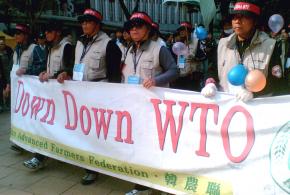Using food as a weapon
explains how food--something that should be a basic human right--is instead used as a tool for profit, as laid out in the new book Stuffed and Starved.
IN THE midst of the worst economic crisis since the Great Depression, some companies are finding that business is booming.
Fast-food giant McDonald's Corp., for example, announced recently that its global sales jumped 7.7 percent in November (4.5 percent in the U.S. alone)--after rising 8.2 percent in October. The sales increases were mainly based on breakfast items and an increase in purchases from the chain's "dollar menu."
And McDonald's is not alone. According to the New York Times, workers at Hormel Foods Corporation have been working seven days a week since July to meet increased demand for the canned-meat product Spam. Spam "seems to do well when hard times hit," said Dan Bartel, business agent for the union local. In this recession, he added, "We'll probably see Spam lines instead of soup lines."
While some economists point to these examples as bright spots in an otherwise bleak economy, the truth is that the proliferation of cheap, nutritionally dubious food is one side of a global food system that is set up not to adequately feed the world's population but to create maximum profits--at the expense of our lives and health.

Author Raj Patel's insightful book Stuffed and Starved: The Hidden Battle for the World Food System dissects the global contradictions of this for-profit system, explaining why, for example, millions go hungry in the developing world, while there is an epidemic of obesity in industrialized nations--disproportionately affecting the urban poor.
A one-time analyst for the World Bank and World Trade Organization (WTO), Patel takes an activist-oriented view at the politics of food across several continents. He begins the journey with some of those suffering the most--small farmers in India. Many have been driven to the brink of desperation and sometimes to suicide as a result of farming policies that enforce an endless cycle of debt as part of a process of "modernization" of the farming industry, often at the behest of organizations like the World Bank and WTO, eager to promote trade liberalization.
In India, Patel notes, suicide--particularly suicide by the ingestion of pesticide--has become common among small farmers who find themselves mired in debt after being forced to take out loans at high interest rates to pay for seeds, irrigation and the pesticides themselves--as part of the implementation of "advances" in farming. Such "advances," however, have actually led to a 20 percent decline in the income of rural families. As Patel notes,
In Punjab, the epicenter of the country's high-tech agricultural "Green Revolution," the United Nations scandalized the government when it announced that, in 1995-56, over a third of farmers faced "ruin and a crisis of existence...This phenomenon started during the second half of the 1980s and gathered momentum during the 1990s." It has been getting worse. According to the most recent figures, suicide rates in Punjab are soaring...
Not all poor farmers kill themselves in India, of course. Rather than suicide, some farmers have sold their kidneys. In Shingnapur, a village in the Amravati district of the Maharashtra, farmers have gone one step further, setting up a "Kidney Sale Center." "We...invited the Prime Minister and the President to inaugurate this kidney shop...Our kidneys are all we have left to sell," said one farmer.
Not only do the world's small farmers not benefit from trade liberalization policies, Patel points out, but consumers--who economists and politicians claim will reap the benefits from these policies--frequently lose as well.
Take the case of the 1994 North American Free Trade Agreement (NAFTA). Prior to NAFTA, 60 percent of cultivated land in Mexico was used to grow corn. After NAFTA, heavily subsidized U.S. corn flooded the Mexican market, and the price of Mexican corn collapsed. Some 1.3 million Mexicans were forced off their land, the poverty rate spiked and industrial wages fell 10 percent as rural workers moved to cities.
As Patel says, this is simply the logic of capitalism. "The creative destruction of modern capital, almost by definition, crushes those least able to protect themselves, and whose contribution to society is priced low."
This is done in the name of "progress," but progress for whom? While the price of Mexican corn was falling due to NAFTA, for example, the price of tortillas--a staple of Mexico's poor--was, paradoxically, rising. Five years after NAFTA went into effect, the price of tortillas had risen sevenfold (because of inflation following the collapse of the peso, the removal of government price controls and the monopoly practices of Gruma, the country's dominant tortilla maker--owned in part by U.S.-based Archer Daniels Midland).
The flood of cheap imports (often highly subsidized by the U.S.) that NAFTA has promoted into Mexico has incited a dramatic change in the Mexican diet, Patel notes, with an increased availability of high-calorie food. Today, Mexicans drink more Coca Cola than milk and eat more wheat-based instant noodles than beans and rice. The country has experienced a spike in obesity rates, and one in 10 Mexicans today suffers from diabetes.
MODERN FOOD policies are intimately tied to the wielding of political power around the globe, says Patel. He quotes British mining magnate Cecil Rhodes, who in 1895 reported on a meeting of the unemployed in East London:
I listened to the wild speeches, which were just a cry for "bread," "bread!" and on my way home I pondered over the scene and I became more than ever convinced of the importance of imperialism...The Empire, as I have always said, is a bread and butter question. If you want to avoid civil war, you must become imperialists.
Britain's ruling class forcefully extracted food, resources and wealth from other nations, notably India, in order to blunt hunger at home. That it was done at a terrible human cost--including exporting food from colonies with starving populations to sell on the British market--was, again, the logic of capitalism.
Food policies since have been intimately tied to political ends as well, he notes, including the U.S. government's use of food aid as a weapon of anti-Communism during the Cold War through the linkage of trade, military power and redistribution of food surpluses. India, for example, became a major recipient of U.S. aid in the 1950s and 1960s as part of a strategy to contain Communism in the country.
Today, Patel notes,
The donation of food as aid continues to be a strategic tool in the negotiating kits of rich and poor countries alike. But although the era of controlling foreign economies through growing their food supply ended in the 1970s, other more subtle means of controlling the food system were being forged. The new political economy of food rested not on control through the United States' food surplus, but through the Global South's fiscal debt.
Poor and developing nations are thus forced by institutions like the International Monetary Fund and World Bank as a condition of their debt to slash price controls keeping food inflation in check, to end social programs and aid to the poor, and even to dump strategic grain reserves under the theory that they are too costly. Such actions have led directly to famine, as in Malawi in 2002.
But as Patel notes, it is not the case that most famines are caused by a shortage of food. Instead, they are caused by a lack of money to buy food. In the case of Malawi, for example, speculators were stockpiling grain. As Patel notes, they were "betting that the famine would drive up maize prices--behaving, in short, precisely as they ought in a free market with high demand and a tight supply."
TODAY, 40 percent of world trade in food is controlled by transnational agricultural corporations like Archer Daniels Midland and Cargill in strategic partnerships with biotech seed and pesticide companies like as Monsanto. These corporations are responsible for, among other things, the proliferation of foods with high fructose corn syrup (usually made in the U.S.) and soy (often manufactured in Brazil and the U.S.)--a direct a result of massive government subsidies and the corporate drive to undercut domestic markets around the globe.
They are aided and abetted by political leaders who accept huge donations from the agribusiness industry. In just this election cycle alone, according to the Center for Responsive Politics, the agribusiness industry gave nearly $2 million to the Obama campaign.
Refreshingly, Patel argues against blaming consumers in the developed world for the poverty and suffering caused by food policies in the developing world--or for the increasing rates of obesity that many claim are the result of individual moral failings and "bad choices."
Rising obesity rates, he notes, are indicative of a failed food system, and "punishing" people--through "obesity taxes" on soda, or, as is planned in Alabama, forcing state employees who are obese to pay a $25 a month "fat fee" surcharge for their health insurance--won't solve the fundamental problem.
As Patel notes, when it comes to food, consumers in industrialized nations are often given the illusion of "choice" without the actuality of it. From the design of supermarkets to the structure of meal times, consumer choices about food are shaped by class, he argues, often in ways that are not even noticed. "[O]ur tastes, and even their timing, are synchronized and set by forces that we rarely acknowledge or even think about...This matters more than one might suppose. Where we live and work shapes what and how we eat and drink."
As Patel stated in an interview with Britain's Guardian in July,
The figure that often stuns people outside the U.S. when I tour with the book is that 20 percent of American fast-food meals are eaten in cars. People are incredulous and ask: is that because Americans so love their cars? But living here you see how hard people work, for a pittance, with no health care, no decent education, not even a hint of a pension--so it's not surprising that the one hot meal you eat a day you eat off your lap.
In other words, when a head of broccoli costs three times as much as a McDonald's double cheeseburger, the whole notion of consumer "choice" becomes suspect.
Thus, while Patel notes the growing popularity of the "Slow Food" movement--which embraces eating organic, locally grown and sustainable food--he is blunt about the fact that consumer choices alone are not enough. (Especially because buying organic, local and high-quality food is often prohibitively expensive as well as too time-consuming for working people and the poor to engage in regularly.)
Patel's theme throughout the book is that any change to the insanities of the modern food system will require a struggle that links the rights of farmers, peasants, agricultural workers and urban workers around the globe. And since the politics of food touches on everything from global trade policy to immigration policy to workers' rights, there are natural allies and opportunities to link various struggles for economic and social justice to a fight for reform of the global food system.
Those struggles are occurring, he notes, from South Korean farmers protesting the WTO; to Mexican protesters taking over every Wal-Mex (Wal-Mart's Mexican counterpart) during demonstrations against the rigged election of President Felipe Calderón in 2006; to campaigns in support of immigrant workers who are refugees of NAFTA's wreckage in Mexico and now work in agricultural and meat-packing industries.
"Organizing," concludes Patel, "of the kind demonstrated by these movements, offers the road to a deeper choice than we have known. Reclaiming the food system, reclaiming our choices, isn't something to be done individually. The way we become singular is plural. That means coming together locally, regionally, and internationally, to better understand the choices we make and the food we eat in the places we make them. As the [Brazilian Landless Workers Movement] put it, 'Against barbarism, education. Against individualism, solidarity.'"


